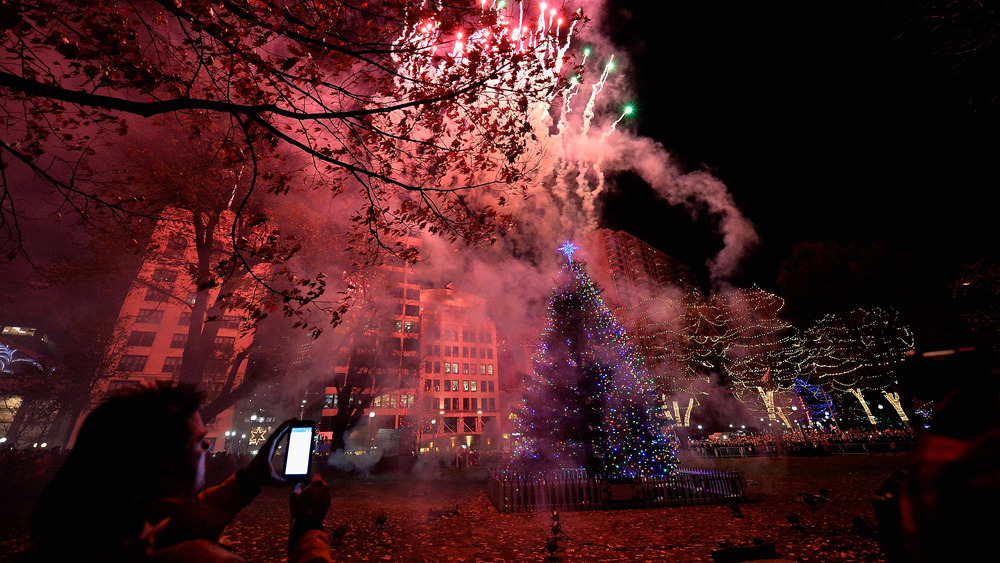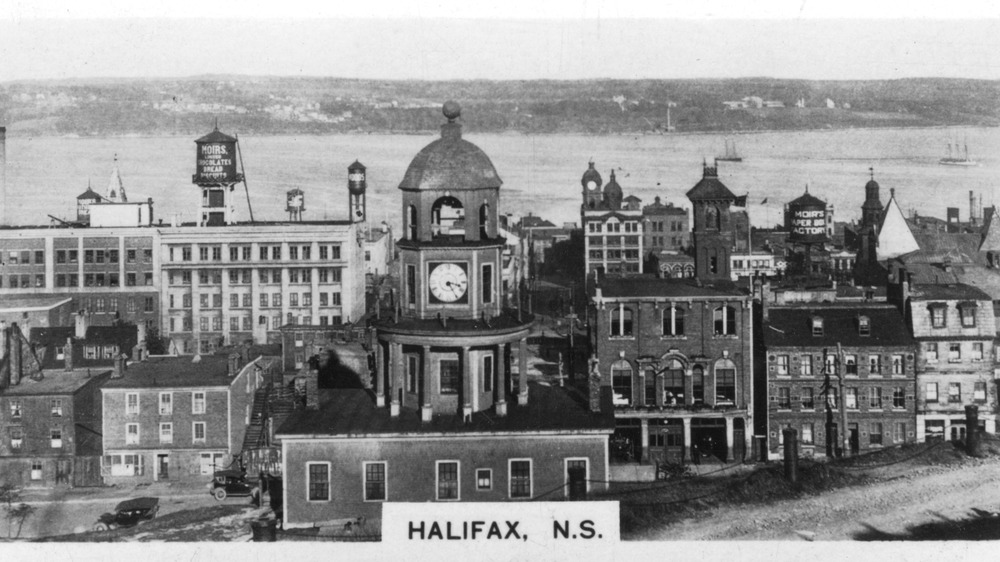Nova Scotia Gives Boston A Christmas Tree Every Year. Here's Why
Like many cities, Boston, Massachusetts holds several Christmas tree lighting ceremonies. Though the ceremony in Rockefeller Center in New York City is perhaps more famous, the one on Boston Common is itself a grand celebration, featuring fireworks and live performances from entertainers. It's capped off by the mayor of Boston lighting an enormous Christmas tree. The Boston Common tree has been a gift from the Canadian province of Nova Scotia for 48 years. Per the Boston Globe, the gift is thanks for the assistance Boston offered to Nova Scotia after the Halifax Explosion of 1917, "the deadliest non-natural disaster in Canadian history."
Halifax, Nova Scotia then had a population of 50,000 and was, at it is now, the largest city in the Atlantic Provinces. During World War I, its port attracted lots of trans-Atlantic traffic thanks to its "naturally deep harbors that were relatively easy to protect." On the morning of December 6, 1917, the SS Mont-Blanc, a French freighter ship carrying almost six million pounds of explosives, was waiting to enter the harbor. In order to avoid attracting the attention of German soldiers, the ship flew no flags warning of its dangerous contents. The SS Imo, a Norwegian steam ship already inside the harbor, was planning to bring supplies from New York to Belgium and was running behind schedule. Once the harbor's anti-submarine nets lifted, the Imo quickly set sail, increasing its speed to beyond the legal limit as it went through the crowded channel leading to the ocean.
The largest man-made explosion ever
After passing a ship on the left, or wrong, side, the Imo was forced to stay in the opposite lane to avoid hitting another boat pulling away from the shore. This put the Imo directly in the path of the oncoming Mont-Blanc. The two ships whistled warnings at each other, but neither made a move to change course until the last minute, when both made a last-ditch effort to avoid colliding. This led to the Imo "grinding into the starboard bow of Mont-Blanc," starting an acid and fuel fire on the Mont-Blanc. The crew, who spoke no English, abandoned ship and tried to convey the danger via frantic gestures, but by that point crowds had amassed on either side of the harbor to watch the ship.
At least two other ships, not knowing what the Mont-Blanc had on board, sent crews to investigate the smoking ship, which soon ran into Pier 6. Upon impact, the Mont Blanc exploded into what was "the largest man-made explosion at the time." Everything within a mile-and-a half-radius was destroyed, including shops, homes, and a sugar refinery. Immediate deaths totaled 1,500, and many more people died in the days that followed, due to the explosion and the fires that raged through Halifax's North End. Over 9,000 people were injured.
A tree to say thank you
Reports of the tragedy spread quickly. Boston Mayor James Michael Curley sent a message to the United States representative in Halifax just hours after the explosion, vowing to send whatever help was necessary. Boston was the first city to respond and within hours, Curley and Governor Samuel McCall had formed the Halifax Relief Committee, printed fundraising notices in the Boston Globe newspaper, and raised over $100,000. Twelve hours after the explosion, a train with 30 physicians, 70 nurses, a 500-bed base hospital unit, and loads of medical supplies set out from Boston to Nova Scotia, with the train tracks throughout the Northeast cleared for the emergency transport. Despite delays due to a blizzard, Boston was the first non-Canadian relief train to arrive. In total, Boston's relief efforts were valued at $750,000, which adjusted for inflation would be $15 million today.
A year later, Nova Scotia sent Boston a Christmas tree as thanks for the city's help in the days following the Halifax Explosion. In 1971, the Christmas tree delivery became an annual tradition. Today, an employee of the Nova Scotia Department of Natural Resources has the responsibility of keeping an eye out for an evergreen worthy of the three-day, 660-mile trek to Boston. The province then holds a tree cutting ceremony and send-off parade for the tree before it travels to Boston to act as the centerpiece at another city-wide celebration.


